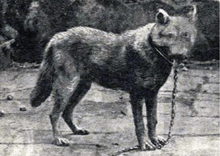Sicilian wolf
The Sicilian wolf (Canis lupus cristaldii) (Sicilian: lupu sicilianu) is an extinct subspecies of the gray wolf that was once endemic to Sicily. It was paler than the mainland Italian wolf and comparable in size to the extant Arabian wolf and extinct Japanese wolf. The subspecies reportedly went extinct due to human persecution in the 1920s, though there were several possible sightings up to the 1970s. It was identified as a distinct subspecies in 2018 through morphological examinations of the few remaining mounted specimens and skulls, as well as mtDNA analyses.
| Sicilian wolf | |
|---|---|
 | |
| Captive specimen, late 19th century. This is the only extant photograph of a live specimen. | |
Extinct (1924, disputed) | |
| Scientific classification | |
| Kingdom: | Animalia |
| Phylum: | Chordata |
| Class: | Mammalia |
| Order: | Carnivora |
| Family: | Canidae |
| Genus: | Canis |
| Species: | C. lupus |
| Subspecies: | †C. l. cristaldii |
| Trinomial name | |
| Canis lupus cristaldii (Angelici & Rossi 2018)[1] | |
Description
The Sicilian wolf was a slender, short-legged subspecies with light, tawny coloured fur. The dark band present on the forelimbs of the mainland Italian wolf are absent or poorly defined in the Sicilian wolf. Measurements taken from mounted museum specimens show that adults had a mean head to body length of 105.4 cm and a shoulder height of 54.6 cm, thus making them slightly smaller than the mainland Italian wolf, which measures 105.8-109.1 cm long and 65-66.9 cm high at the shoulder.[1]
History
The Sicilian wolf likely entered Sicily via a land bridge that formed 21,500-20,000 years ago. Its decline likely began during the late Norman period, when its ungulate prey went extinct. The subspecies went extinct during the 20th century, but the exact date is unknown. It is generally thought that the last wolf was killed in 1924 near Bellolampo, though there are reports of further kills between 1935 and 1938, all in the vicinity of Palermo. Several sightings are also reported from 1960 and 1970.[1]
In 2018, an examination of the holotype – a mounted specimen and its skull stored at the Museo di Storia Naturale di Firenze – and three others confirmed the morphological distinctiveness of the Sicilian wolf, and an examination of the mtDNA extracted from the teeth of several skulls showed that the subspecies possessed a unique haplotype, distinct from that of the Italian wolf.[1]
In 2019, an mDNA study indicated that the Sicilian wolf and the Italian wolf were closely related and formed an "Italian clade" that was basal to all other modern wolves except for the Himalayan wolf and the now-extinct Japanese wolf. The study indicates that a genetic divergence occurred between the two lineages 13,400 years ago. This timing is compatible with the existence of the latest land bridge between Sicily and southwestern tip of Italy, which flooded at the end of the Late Pleistocene to form the Messina Strait.[2]
References
- Angelici, F. M.; Rossi, L. (2018). "A new subspecies of grey wolf (Carnivora, Canidae), recently extinct, from Sicily, Italy" (PDF). Bollettino del Museo Civico di Storia Naturale di Verona. 42: 3–15.
- Reale, S.; Randi, E.; Cumbo, V.; Sammarco, I.; Bonanno, F.; Spinnato, A.; Seminara, S. (2019). "Biodiversity lost: The phylogenetic relationships of a complete mitochondrial DNA genome sequenced from the extinct wolf population of Sicily". Mammalian Biology. 98: 1–10. doi:10.1016/j.mambio.2019.06.002.